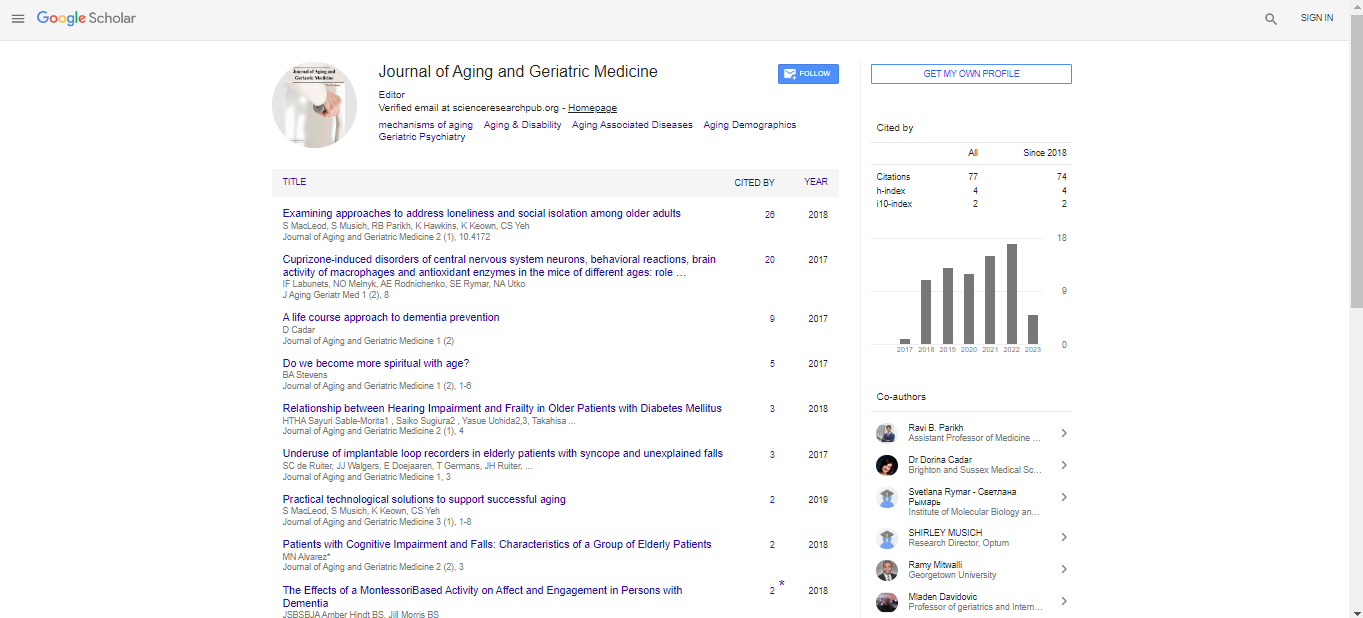Editorial, J Aging Geriatr Med Vol: -8 Issue: 1
Understanding Alzheimer's Disease: A Growing Health Crisis
Abdulla Lyla*
Department of Social Preventive Medical Sciences, Imperial College London, United Kingdom
- *Corresponding Author:
- Abdulla Lyla
Department of Social Preventive Medical Sciences, Imperial College London, United Kingdom
E-mail: lyla037@gmail.com
Received: 01-Jan-2025, Manuscript No. agm-25-169742; Editor assigned: 4-Jan-2025, Pre-QC No. agm-25-169742 (PQ); Reviewed: 18-Jan-2025, QC No. agm-25-169742; Revised: 25-Jan-2025, Manuscript No. agm-25-169742 (R); Published: 30-Jan-2025, DOI: 10.4172/2576-3946.1000176
Citation: Abdulla L (2025) Understanding Alzheimer’s Disease: A Growing Health Crisis. J Aging Geriatr Metd 8:176
Introduction
Alzheimer’s disease is a progressive neurodegenerative disorder and the most common cause of dementia, affecting millions of individuals worldwide. As global life expectancy increases, so does the prevalence of this devastating condition. Alzheimer's is not just a disease of memory loss; it gradually erodes cognitive functions, independence, and ultimately, identity. Understanding its causes, symptoms, diagnosis, treatment options, and societal impact is crucial for addressing the challenges it poses to patients, caregivers, and healthcare systems [1].
Alzheimer’s disease is a progressive neurodegenerative disorder that primarily affects older adults and is the most common cause of dementia worldwide. It is characterized by a gradual decline in memory, thinking, behavior, and the ability to perform everyday activities. First identified by Dr. Alois Alzheimer in 1906, the disease has since become one of the most significant public health challenges of the 21st century, particularly as global populations continue to age [2].
The hallmark features of Alzheimer’s include the accumulation of amyloid-beta plaques and tau tangles in the brain, which interfere with normal neuronal function and ultimately lead to cell death. These changes cause the brain to shrink over time and disrupt essential cognitive processes. Although aging is the greatest known risk factor, Alzheimer’s is not a normal part of the aging process. Genetics, lifestyle factors, and underlying health conditions such as cardiovascular disease also contribute to its onset and progression [3].
Alzheimer’s develops slowly and worsens over time, progressing from mild forgetfulness to severe cognitive impairment and complete dependency. It not only affects the individual diagnosed but also places a significant emotional, physical, and financial burden on families and caregivers. Currently, there is no cure, but early diagnosis and appropriate management can help improve quality of life and delay disease progression [4].
With millions of people affected worldwide and numbers expected to rise sharply in the coming decades, Alzheimer’s disease represents a growing global health crisis. Research efforts are ongoing to better understand its underlying mechanisms, develop more effective treatments, and ultimately find a cure. Public awareness, early intervention, and support for caregivers are also essential components of addressing the multifaceted challenges posed by this complex condition [5].
Discussion
Alzheimer’s disease (AD) is a chronic, progressive neurological disorder that primarily affects memory, thinking, and behavior. It is the most common cause of dementia, accounting for 60-80% of cases worldwide. The disease’s hallmark features include the accumulation of amyloid-beta plaques and tau protein tangles in the brain, which disrupt neural communication and lead to neuronal death. Although the precise cause of AD remains unclear, a combination of genetic, environmental, and lifestyle factors is believed to contribute.
The clinical presentation typically begins with subtle memory loss and difficulty performing familiar tasks, gradually progressing to impaired judgment, language difficulties, disorientation, and personality changes. As the disease advances, patients require extensive assistance with daily activities, ultimately leading to complete dependence.
Diagnosing Alzheimer’s disease involves clinical evaluation, cognitive testing, and neuroimaging, but definitive diagnosis can only be confirmed post-mortem. Advances in biomarkers and imaging techniques, such as PET scans and cerebrospinal fluid analysis, have improved early detection and differentiation from other dementias.
Treatment options for AD are currently limited to symptomatic relief; cholinesterase inhibitors and NMDA receptor antagonists can modestly improve cognition and delay progression but do not stop the disease. Research into disease-modifying therapies targeting amyloid and tau is ongoing but has faced significant challenges.
Beyond the patient, AD profoundly impacts families and caregivers, often leading to emotional, physical, and financial strain. This underscores the importance of comprehensive care approaches that include medical management, caregiver support, and community resources.
In conclusion, Alzheimer’s disease remains a major public health challenge with significant societal implications. Continued research, early diagnosis, supportive care, and public education are critical to improving outcomes and preparing for the increasing number of individuals affected by this devastating condition.
Conclusion
Alzheimer’s disease is one of the most pressing health challenges of our time. As science advances, so does our hope for better treatments and eventually a cure. Until then, raising awareness, supporting patients and caregivers, and promoting brain-healthy lifestyles remain essential strategies in our collective effort to combat this complex disease. Ultimately, addressing Alzheimer’s disease requires a multifaceted approach involving medical, social, and community resources. By advancing scientific understanding and fostering compassionate care, society can better support individuals affected by Alzheimer’s and work toward a future where the burden of this devastating disease is significantly diminished.
References
- Shah Z, Chawla A, Patkar D, Pungaonkar S (2003) "MRI in kernicterus". Australas Radiol 47: 55-57.
- Gómez M, Bielza C, Pozo FD, Rios Insua S (2007) "A graphical decision-theoretic model for neonatal jaundice". Med Decis Making 27: 250-265.
- Gilmour, Susan M (2004) "Prolonged neonatal jaundice: When to worry and what to do". Paediatr Child Health 9: 700-704.
- Duryea EL, Hawkins JS, McIntire DD, Casey BM, Leveno KJ (2014) A revised birth weight reference for the United States. Obstet Gynecol 124: 16-22.
- Nesbitt TS, Gilbert WM, Herrchen B (1998) Shoulder dystocia and associated risk factors with macrosomic infants born in California. Am J Obstet Gynecol 179: 476-480.
Indexed at, Google Scholar, Crossref
Indexed at, Google Scholar, Crossref
Indexed at, Google Scholar, Crossref
Indexed at, Google Scholar, Crossref
 Spanish
Spanish  Chinese
Chinese  Russian
Russian  German
German  French
French  Japanese
Japanese  Portuguese
Portuguese  Hindi
Hindi 